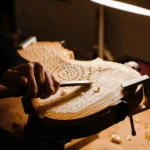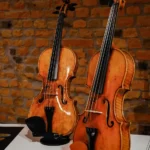Contemporary vs Modern Violins
Back to BlogContemporary vs. Modern Violins
In the world of music and craftsmanship, the violin is a timeless masterpiece cherished for its ability to produce melodies. Yet, within the world of violin making, a fascinating duality is represented by modern and contemporary violins.
While both are the products of exceptional skill and dedication, they embody distinct chapters in the ongoing saga of violin craftsmanship. The choice between a modern or contemporary violin, viola, or cello can be akin to selecting between the classic and the avant-garde, each offering a set of characteristics and qualities.
Join us on a journey through the world of string instruments as we explore the differences and nuances between these two extraordinary types of violins, shedding light on their unique attributes and helping you make an informed decision in your pursuit of musical excellence.
Modern and Contemporary in the context of violins
Before delving into the comparison between modern and contemporary violins, it’s essential to establish what these terms mean in violin making.
Modern Violins: Modern violins typically refer to instruments crafted from the late 19th century to the mid-20th century. These violins were made using traditional techniques and materials that have been refined over centuries. While they may incorporate innovations and improvements, they generally adhere to the classical design principles of renowned makers like Antonio Stradivari and Giuseppe Guarneri del Gesù.
Contemporary Violins: Contemporary violins, on the other hand, encompass instruments crafted from the mid-20th century to the present day. What sets contemporary violins apart is their departure from strict adherence to traditional methods. Contemporary luthiers often experiment with new materials, designs, and techniques to create violins that cater to the evolving needs of musicians and the demands of modern music.
Some people get confused between modern instruments and the term modernization of instruments, which are two completely different things. Baroque instruments have been modernized in recent centuries to reflect societal changes, such as changes in musical tastes, trends, and innovations. The main reason for these changes was musicians’ demand to increase their overall sound and volume.
A journey through time with stringed instruments
Violin-making history is a rich tapestry of artistry, innovation, and tradition. Understanding this evolution is crucial to appreciating the differences between modern and contemporary violins.
The roots of the violin and viola can be traced back to the early Renaissance period, but it was in 16th-century Italy that the instrument began to take its modern form. Makers like Andrea Amati and his descendants in Cremona pioneered the crafting of violins as we know them today.
During the Golden Age of violin making in the late 17th and early 18th centuries, masters like Antonio Stradivari and Giuseppe Guarneri del Gesù created instruments renowned for their unmatched tonal qualities and craftsmanship. These instruments have become iconic and are benchmarks for modern and contemporary makers.
As the 19th century dawned, violin-making saw continued innovation, with luthiers experimenting with different shapes, sizes, and varnishes. The 20th century witnessed the rise of modern violin makers who preserved traditional techniques while embracing technological advancements.
Today, contemporary violin makers are pushing boundaries, exploring new materials, and adapting to the changing demands of musicians. This brings us to the intriguing comparison between the two worlds of violin craftsmanship: modern and contemporary violins.
The Advantages of Owning a Modern or Contemporary Violin
- If you don’t have a big budget, you should choose a better modern violin maker than the old options available within your budget. Finding an antique violin that sounds very, very good requires significant money. That’s why sometimes you will find a better contemporary/modern playing violin.
- You get to know the maker, and they get to know you. It is possible to understand what happens inside their workshop and for you to specify every part of a violin the way you want. Not to mention that you can always rely on the luthier if your instrument needs repairs or changes in the future. Remember that the luthier has the best interest in keeping your instrument sounding at the best of its possibilities.
- The modern maker knows their instrument from the inside out. They know precisely how to take good care of it. On the other hand, old violins might have suffered so many restorations and changes executed by so many different luthiers across the centuries their originality might not be intact anymore. Adjustments are easier on modern violins, for sure!
- The contemporary and modern violins already born with high-quality sound, timber, colors, and projection will get better over time. It is different from old fine violins, which usually immediately give you what they have.
- Easier trade-in or resale of the instrument later in life.
- You will hardly have trouble with attributions and certificates on a contemporary violin.
The Disadvantages of Owning a Modern or Contemporary Violin
- It takes a bit longer to develop its sound, unlike an old violin that you already know what it sounds like. However, top contemporary violin makers are already creating instruments born with a sound comparable to old fine Italian violins.
- It usually requires more adjustments within the first months or years. It’s part of the process to maintain the instrument through its development. Don’t think that the instrument has something wrong. It’s completely normal and reasonable to make adjustments frequently. Not to mention that it’s done according to the necessity of the musician.
Contemporary and Modern Violins Sound Comparison
When comparing the sound of modern and contemporary violins, it becomes evident that they offer distinct tonal characteristics. Modern violins, built following traditional craftsmanship, often produce a well-balanced and refined sound. They are celebrated for their clarity, projection, and versatility, making them favored by classical musicians. On the other hand, contemporary violins embrace innovation in design and construction. Their sound can vary widely, offering unique tonal colors and timbres that may suit different musical genres and playing styles. Some contemporary violins explore unconventional materials and forms, allowing luthiers to experiment with the instrument’s acoustic properties.
Research about Modern vs. Contemporary Violin
Setting aside the historical value of these magnificent instruments, many scholars have questioned whether violins made by the great luthiers of the modern era are genuinely better than those crafted by contemporary luthiers. Another question raised by scholars was to discover the secret of the ancient masters in creating their true works of art.
According to some violinists, the significant difference between old violins produced by the best luthiers of the time and those made today is the strength of these instruments in a concert hall.
In a study conducted by American and Dutch researchers using computer tomography, it was discovered that the wood density used in those ancient times was more homogeneous than the raw materials used in making violins today. Scientists already knew that a tree, in its natural growth, produces rings of different colors, but they found that the density of the growth rings in the wood used in older instruments was significantly lower.
In this way, it is possible to explain the superior sound of ancient violins with differences in density levels, which could affect vibration and, consequently, the sound itself. This is a point of discussion when analyzing what is distinct in the acoustics of modern violins and contemporary violins.
On the other hand, several studies have shown that these centuries-old violins are not necessarily superior to modern ones. There is no doubt that these violins not only have excellent construction quality but also hold significant historical value.
However, many internationally renowned violinists prefer modern instruments, considering their excellent high sound quality.
Among the various studies comparing modern violins, some built more than 300 years ago, with contemporary violins, one stands out, conducted by the University of Paris. It demonstrated that most of the 21 professional violinists participating in a simple test could not distinguish the difference in sound between various types of violins, old and recent.
What was even more curious was another result when they were asked which of the instruments they had played they would like to take home. The musicians’ response was surprising: they preferred contemporary violins.
The preference of many musicians for old fine violins is part of human imagination and traditions that describe these true works of art as unsurpassed instruments and creators of beautiful sound.
These violins created by great masters of the past are true icons that can be worth millions of dollars. However, violins built today by well-known international luthiers can be just as good or even superior to those from the modern era.
Price and Market Value for Modern and Contemporary Violins
Modern and contemporary violins’ price ranges and market values can vary significantly. Modern violins, often crafted by skilled luthiers with established reputations, may command higher prices, especially if they carry the legacy of renowned makers. In contrast, contemporary violins may offer a wider price range, influenced by factors such as the luthier’s reputation, materials used, and the instrument’s uniqueness. Some contemporary instruments, especially those made by emerging luthiers, can be more affordable, making them accessible to a broader range of musicians. Demand from musicians, collectors, and investors influences the market for both modern and contemporary violins, which can impact pricing and market value.
Contemporary vs. Modern Violins
In the timeless world of violin, viola, and cello, choosing between modern and contemporary instruments is a matter of personal preference, style, and musical goals. Each category offers a distinct set of qualities that cater to the diverse needs of violinists.
Modern violins, rooted in centuries of craftsmanship, create a refined and balanced sound that has captivated generations of classical musicians. Their playability, often based on well-established designs, provides performers with familiarity and comfort. While modern violins may come with a higher price tag, they carry the legacy of renowned makers, making them sought after by collectors and musicians alike.
Contemporary violins, on the other hand, embrace innovation, offering a broad spectrum of tonal colors and timbres. Their playability can be customized to suit individual preferences, enhancing a musician’s comfort and technique. The price range for contemporary violins varies widely, making them accessible to musicians of different backgrounds and aspirations.
Ultimately, the decision between modern and contemporary violins hinges on your musical journey. Consider your genre, style, and performance needs when making your choice. Whether you opt for the timeless elegance of a modern violin or the innovative spirit of a contemporary instrument, what matters most is the music you create and the connection you forge with your chosen companion in sound.
Both modern and contemporary violins have their place in the orchestra of musical expression, enriching the world with their unique voices and contributing to the enduring legacy of this beloved instrument. So, explore, experiment, and let your violin carry your musical dreams into the future.
Explore Our Collection
Are you inspired to embark on a musical journey with the perfect violin by your side? Discover a symphony of choices in our exquisite modern and contemporary violin collection. From the rich, time-honored tones of modern craftsmanship to the innovative melodies of contemporary design, our collection offers a treasure trove for musicians and collectors alike.









